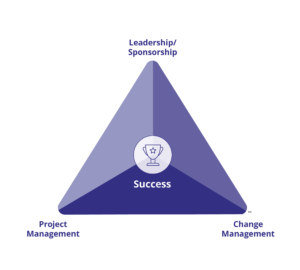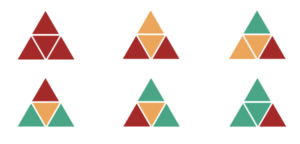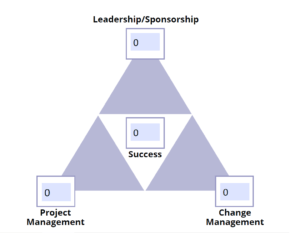Assess Your Project’s Potential with the PCT Assessment
The Prosci Change Triangle (PCT) Model is a simple but powerful framework for understanding the four critical aspects of any successful change effort:
- Success: clarity on the aim or purpose of the initiative.
- Leadership/sponsorship: provides strategy, direction and guidance.
- Project management: addresses the technical side of change by designing, developing and delivering the solution.
- Change management: addresses the people side of change by enabling people to engage, adopt and use the solution to achieve results and outcomes.
If a project is missing any of the 4 components, it will struggle or fail. Below are ten questions from the PCT Assessment for each of the four factors that enable you to evaluate the health of a particular project or initiative.
 When use PCT Assessment?
When use PCT Assessment?
Complete an initial PCT Assessment early in the lifecycle of the project to establish a baseline. Conduct the assessment again at key points during the project to see if scores are improving. Each time the assessment is conducted, create a set of action plans to improve performance where scores are low.
Who should use PCT Assessment?
The PCT Assessment can be completed by the change management team, project team, senior leaders and key business leaders from the impacted groups.
Scoring for the PCT Assessment
Each of the questions below should be scored 1 to 3 on the following scale:
- 1 = Inadequate. A score of a 1 means that your project fails to meet the qualities described in the statement
- 2 = Adequate. A score of a 2 means that your project meets the qualities described in the statement, however this is not viewed as a strength of the project
- 3 = Exceptional. A score of a 3 means that not only do the qualities exist for your project but they are also considered a strength or asset to the overall project
The “SUMMARY” button only works when all 40 cells are filled.
| Success | |
| 1. Inputs into the change management process are defined (may include a business case, charter, scope, or plan). | |
| 2. Organizational benefits are fully defined (what the organization gains). | |
| 3. Project objectives are fully defined (what the project achieves). | |
| 4. Adoption and usage objectives are fully defined. | |
| 5. Units of measure for benefits and objectives are established. | |
| 6. Benefits and objectives are prioritized. | |
| 7. Benefit and objective ownership is designated. | |
| 8. People dependency of benefits and objectives is evaluated. | |
| 9. The definition of success is clear and ready to be communicated. | |
| 10. The sponsorship coalition is aligned to a common definition of success. | |
| Sum of points for Success (out of 30 total) |
| Leadership/Sponsorship | |
| 1. The change has a primary sponsor with the necessary authority over the people, processes and systems to authorize and fund the change. | |
| 2. The primary sponsor can clearly explain the nature of the change, the reason for the change, and the benefits for the organization. | |
| 3. The organization has a clearly defined vision and strategy. | |
| 4. The change is aligned with the strategy and vision for the organization. | |
| 5. Priorities are set and communicated regarding the change and other competing priorities. | |
| 6. The primary sponsor is resolving issues and making decisions related to the project schedule, scope and resources. | |
| 7. The primary sponsor is actively and visibly participating throughout the lifecycle of the change. | |
| 8. The primary sponsor is encouraging senior leaders to participate in and support the change by building a sponsor coalition. | |
| 9. The primary sponsor is building awareness of the need for the change directly with employees. | |
| 10. The primary sponsor is visibly reinforcing the change by celebrating successes and addressing resistance. | |
| Sum of points for Leadership/Sponsorship (out of 30 total) |
| Project Management | |
| 1. The nature of the change is clearly defined including who is impacted and how. | |
| 2. The project has specific objectives. | |
| 3. The project has a clearly defined scope. | |
| 4. The project has a project manager assigned to manage the project lifecycle. | |
| 5. Project milestones are identified and a project schedule is complete. | |
| 6. A work breakdown structure with deliverables is complete. | |
| 7. Resources for the project are identified and acquired. | |
| 8. Periodic meetings are scheduled with the project team and key stakeholders to track progress and resolve issues. | |
| 9. The project manager understands the value of change management in ensuring the change will be adopted and used. | |
| 10. The Change Management Plan is integrated with the Project Management Plan. | |
| Sum of points for Project Management (out of 30 total) |
| Change Management | |
| 1. The change is applying a structured change management approach to deliver the benefits to the organization. | |
| 2. An assessment of the change and its impact on individuals and the organization is complete. | |
| 3. An assessment of the change risk is complete. | |
| 4. The change has specific adoption and usage objectives. | |
| 5. An assessment of the strength of the sponsor coalition is complete. | |
| 6. A customized and scaled change management strategy with the necessary sponsorship commitment is complete. | |
| 7. The resources required to execute the change strategy and plans are identified, acquired and prepared. | |
| 8. Change management plans that will mitigate resistance and achieve adoption and usage are complete and are being implemented. | |
| 9. The effectiveness of change management is being monitored and adaptive actions are being taken if required to achieve adoption and usage. | |
| 10. The organization is prepared to own and sustain the change. | |
| Sum of points for Change Management (out of 30 total) |
Assessment Score Interpretation
| Assessment Score Interpretation | This factor is a strength of the project and should be leveraged. |
| 25 – 30 | Strength – should be leveraged and maintained |
| 20 – 24 | Alert/possible risk – needs further investigation |
| under 20 | High risk/threat – needs immediate action |
Plotting your PCT Assessment Profile
The results of the Prosci PCT Assessment show the PCT Model profile for a given project or initiative. The simple calculator in this tutorial does not plot your scores for you, but Prosci’s PCT Analyzer generates the resulting graph as well as a color-coded representation of your scores.

6 Examples PCT Profiles
The shapes of the PCT profiles created above can provide some insight into how your project is going and which areas require your attention and resources.
We encourage you to have a free consultation where you can analyze your results. Each component of the Prosci PCT Model is color coded to indicate strengths, cautions and areas at risk. Make an appointment!
Use the PCT Model and evaluate the potential of your project with our expert – check the offer

